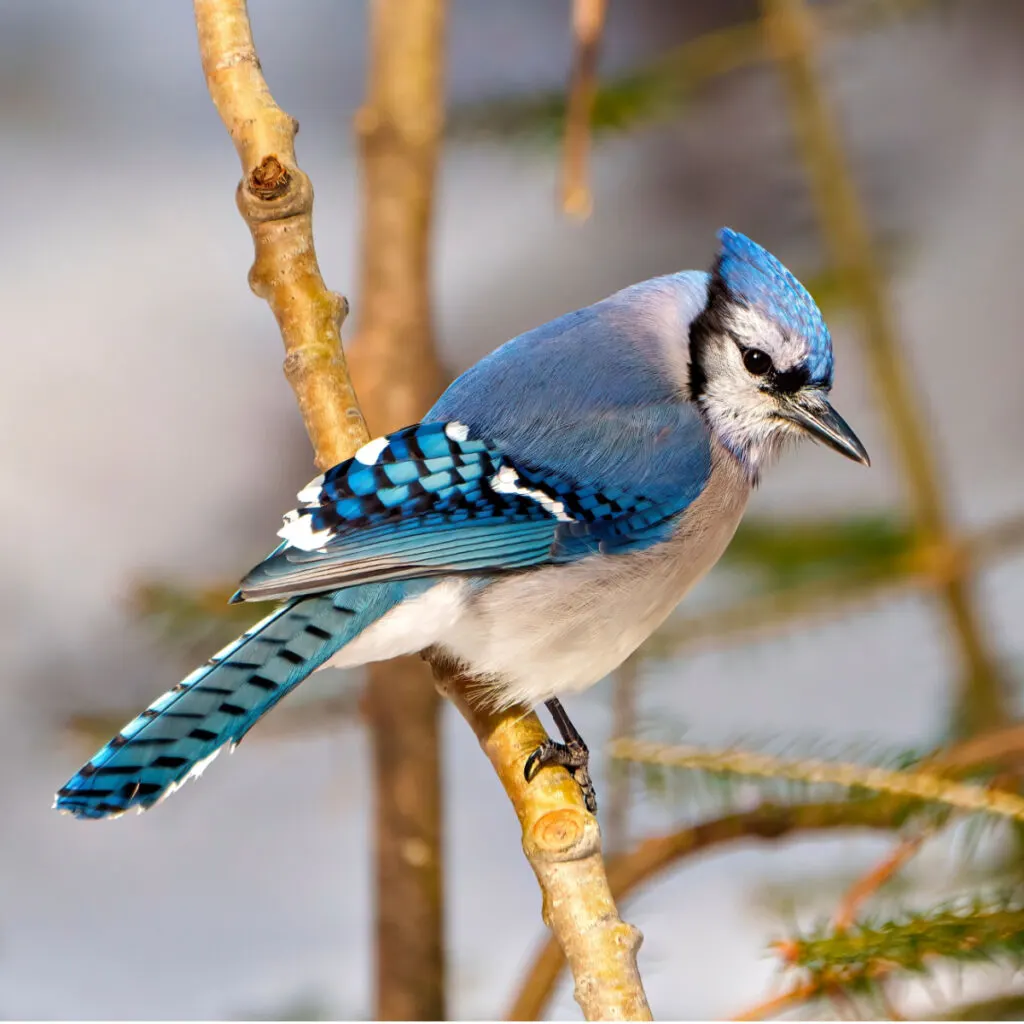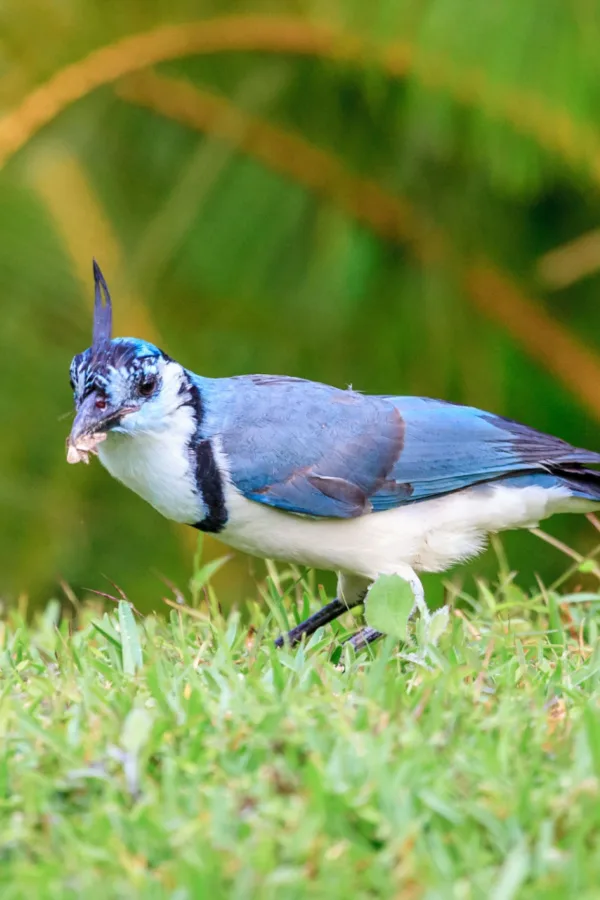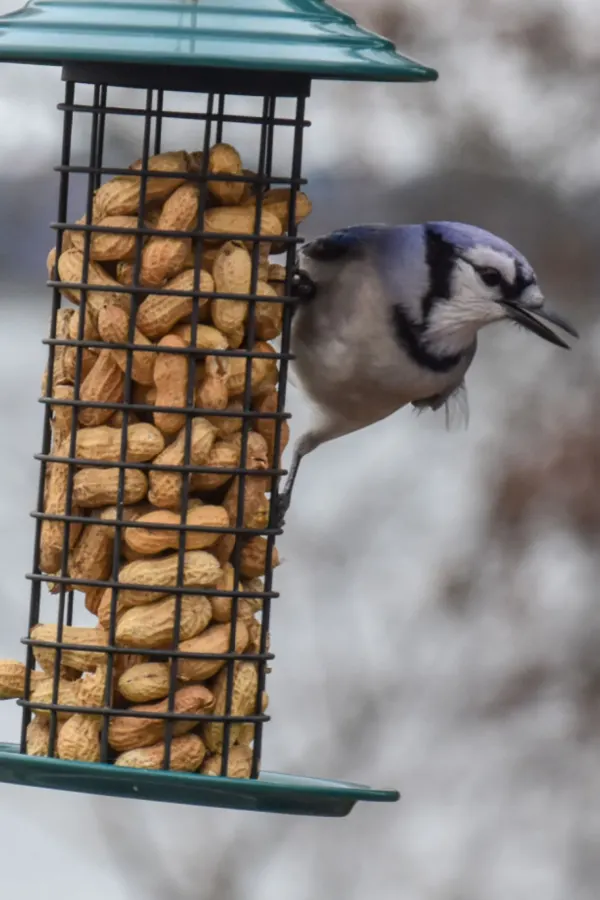Looking for how to feed blue jays in your yard and still keep all of the other beautiful birds you love to watch visiting too?
Blue jays are notorious for being among the most protective birds around. They are often thought of as quite unfriendly and downright mean when it comes to their ability to share backyard spaces with other bird species. Especially when it comes to sharing the bird seed in feeders!
But to be fair, while it is true that blue jays are extremely protective and can be one of the more aggressive of birds species when protecting their nests and food sources, they are not actually as mean and unfriendly as they are often made out to be.

The Truth About Blue Jays – How To Feed Blue Jays & Keep Other Birds Around
As it turns out, there are actually quite a few misconceptions about blue jays. For starters, unlike cardinals and many other birds, the male is not the only sex to sport bright colors. Both female and male blue jays have bright blue coloring. Because of that, the only real way to tell the difference is size, with males tending to be larger.
Even more, far from hurting other bird species, as you will see below, in many cases, blue jays actually help protect many smaller species of birds in your backyard from other predators.
And if all of that wasn’t enough to change your mind on blue jays, these insect birds can also be quite beneficial for gardeners. In fact, they happen to be one of the best birds of all for keeping insect populations under control.
So how do you get blue jays to play nice? As it turns out, keeping all of the birds in your backyard happy and content all comes down to how and where you feed them!

How To Feed Blue Jays – And Keep Other Birds Around!
Blue jays are one of the most intelligent of all backyard birds. They are able to quickly find food sources. And when they do, they try to create their nests nearby. This way, they can feed young with little need to forage for food at a distance. Unfortunately, when there is only one source of food, they will monopolize it and drive other users away.
In the case of squirrels and chipmunks raiding your bird houses, this can actually be a good thing. When blue jays are around, these two bird feed robbing animals are far less likely to visit. But, of course, blue jays will also drive away many other birds that compete for that same food.
The best way to fix this situation is to supply the blue jays with their own feeder. And to fill that feeder with the food sources blue jays love the most. At the same time, you can then feed your other birds with a feeder far away. And to stop blue jays at that feeder, you simple fill it with feed that they are not typically fond of.
Because blue jays are so intelligent, when they have access to the food they love most, they will gravitate toward it. And even better, they will leave the other “less desirable” feeders alone in the process.

This trick works especially well if you happen to have a backyard space that is large enough to place the two feeders far apart. And – if you also can place the blue jay feeder closer to where they like build their nests, you will have even more success!
Using Blue Jay Only Feeders – How To Feed Blue Jays
Blue jays are fond of two very specific types of feeders – tray feeders and wreath or cage feeders. Tray feeders are flat feeders that allow blue jays to perch with ease for a meal. Tray feeders not only allow for multiple foods that blue jays love, they also make viewing them feeding quite easy. Affiliate Link : Hanging Bird Tray Feeder
Wreath and cage feeders are exactly as they sound – feeders that have a cage that holds food inside. The blue jays then perch outside on the wire and feed through the holes in the cage. For blue jays, cage and wreath feeders are excellent for filling with larger nuts and even suet, a blue jay favorite in the winter time. Affiliate Link: Hanging Peanut Wreath Bird Feeder
As for the foods they love most, nuts win out in a big way. Blue jays love peanuts (in and out of their shells), beech nuts, walnuts and acorns. In addition they also love corn, cracked corn, sunflower seeds, and as mentioned above, suet.

Tray feeders filled with nuts, corn and sunflower seeds will attract blue jays like a magnet. Although other birds do like tray feeders, one filled with blue jay loving food will tend to become theirs by default. Again, they are very good at protecting their food sources – even from hungry squirrels!
Where To Hang Blue Jay Feeders – How To Feed Blue Jays
First and foremost, it’s important to hang your blue jay feeders as far away from your regular bird feeders as possible. In addition, try to locate it out of the sight line of your other feeders. Placing your feeders on opposite sides of your house is the best method for success.
For blue jays, if you are able to place your feeders near large trees or a wooded edge, even better. It is up in large trees or at the edge of woods where they like to build nests. And if their feeder is nearby, they likely will stay there.
Keeping Blue Jays Away From Other Feeders – How To Feed Blue Jays
In addition to locating your other bird feeders away from your blue jay feeders, to really get the birds to co-exist without issue, the final piece of the puzzle is to fill your main feeders with foods blue jays snub their beaks at. Or more to the point, mix those foods in with ones they will eat to make them less attractive.

For blue jays, nyjer thistle and safflower seeds are at the top of the “don’t like, won’t touch” list. Although many small birds like finches love these smaller seeds, blue jays do not. By simply mixing in these seeds with your regular bird feed, you can keep the cardinals, chickadees, finches and more coming without interruption.
As long as the blue jay’s main food sources are available at another feeding location, they will almost always leave feeders with these seeds in them alone. But the good news is, by keeping blue jays around, they will drive off eagles and hawks which can be quite dangerous for smaller birds.
Here is to attracting beautiful blue jays to your yard – and to still keeping the peace with other feathered friends you like to feed as well! For more bird feeding tips, check out our article on How To Attract And Feed Chickadees.
Follow Our Facebook Page For Great Gardening Tips And Advice! This Is My Garden Facebook Page
This Is My Garden is a garden website created by gardeners, for gardeners. Jim and Mary Competti have been writing gardening, DIY and recipe articles and books and speaking for over 15 years from their 46 acre Ohio farm. They publish three articles every week, 52 weeks a year. Sign up today to follow via email, or follow along!
